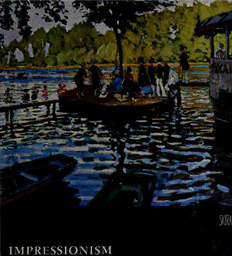
Impressionism PDF
Preview Impressionism
» r+. * *«fc cc Br-1 - *& i m • .}^fr*k Cfl Jf **, J35* .'•'^^2^'^^jjji *•* US -y^H -?8( m _!A2 ru • 3^?« IMPRESSIONISM M PR ESSION1 SM I FIRST VOLUME j2 Color Plates THE ORIGINS OF IMPRESSIONISM THE TRIUMPH OF OPEN-AIR PAINTING A PICTURE OF THE MODERN WORLD [MP ESSION1 SM R SECOND VOLUME 6 Color Plates J Till GROUP EXHIBITIONS OF 1874, 1876, 1877, 1879, l88o l88l > > 1882, 1886 NEO-IMPRESSIONISM AND THE SCIENCE OF COLORS A VISION OF THE COSMOS AND rill PAINTING 01 oi'R TIME IWsIKill! Ill) in r.|, \. nv 1X11 \ inc., PUB! ISH1ks lUl111 wiM 1 .m u ->0«R i(..s.\. THE TASTE OF OUR TIME Collectionplannedanddirectedby ALBERT SKIRA BIOGRAPHICAL AND CRITICAL STUDY BY JEAN LEYMARIE Curator of Grenoble Museum * FIRST VOLUME Translated by James Emmons Impressionism m Title Page: Pissarro, Upper Norwood Road with a Carriage (detail), 1871. Ncuc Staatsgalcric, Munich. All reproduction rights rrscrved l>v Svndicat de la Propria Artistique, Pari*, and Association pour la Defense des Art* plagrtqnw ct graphiqucs (AJXA.P.G.), Paris. Library of Congress Catalog Card Number: 55-7701. This two-volume study ofImpressionisminaugurates a series ofsuch studies,devotedtotheleadingmovements ofmodern painting, which in due course will appear alongside the mono- graphs on individual painters published under the general heading of "The Taste of Our Time." The complexity of the impressionist movement and the wealth of available material are such that two volumes were necessary to cover it adequately. The first tells the story of Impressionism up to the pivot year of 1872: the rise ofopen-air painting and the swing-overfrom a dramatic realism that played onthe emotions to anaturalism, orratheranaturalwayofseeing the world, devoid of moral or sentimental implications, essen- tially objective, essentially poetic. Once we see these two trends in their proper perspective, we see how the new generation of Manet and the Impressionists stood with respect to Courbet and the Barbizon School. The uphill struggle against embattled Academicism hinged on the choice of subject-matter, and this proved to be the test for 19th-centurypainters. Allindependent- minded artists embraced the "modern aesthetic" of Baudelaire, who urged them to open their eyes to the contemporary scene, to paint the life being lived around them in city and country. This was the rallying cry to which Impressionism answered, and as we follow the rise of the movement we also follow the whole artistic and literary life of its time, the manners and morals ofthe period, urban development and scientificprogress. The relevant documentary material will be found at the end ofthe second volume. This opens with theyear 1873,which found the group in confident possession of a fully worked-out technique. Its mature style is seen at its best in the canvases painted at Argenteuil and Pontoise in the seventies, the happy period of perfect balance and cohesion. Manet's death in 1883 coincided with the breaking up of the impressionist group. Each artist thereafter went his own way, while at the same time a vigorous neo-impressionist generation stepped on to the scene; to the latter an important chapter is devoted. Impres- sionism, while sowing the seeds of its own destruction, broke the ground for all modern art, and there is no understanding Cezanne, Seurat, Van Gogh, even Matisse, without under- — standing the movement that set them free a movement each of them completed even while repudiating it. Bonnard's art was the apotheosis of Impressionism. Gauguin, on the other hand, championthathewas ofsymbolismandabstraction, stood resolutely opposed to an art that relied so heavily on the data ofthe visual world. At last, in 1890, after adecade ofvicissitude, the great masters ofImpressionism reverted to the ideals oftheir youth, but greatly amplified now, cosmic and visionary. The text is developed simultaneously from the historical, critical and aesthetic angles. Chosen and arranged with great care, the plates go hand in hand with the text. Together they give a lucid, coherent picture of the magnificent variety of expression and the steadfast spiritual unity that characterized — Impressionism that unexampled concourse of great painters, whose work, even while pointing to the future, held up both a poetic and a truthful mirror to life as it was lived in their time.
